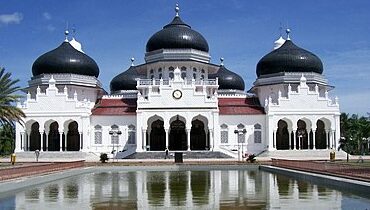
Christianity
Christianity originated in the region in the 1st century AD, and was one of the major religions of the region until the Muslim conquests of the mid-to-late 7th century AD. Christianity in the Middle East is characterized with its diverse beliefs and traditions compared to other parts of the old world.

Chapel of Saint Ananias, Damascus, Syria, an early example of a Christian house of worship; built in the 1st century AD
Christians now make up five percent of the population, down from 20 percent in the early 20th century. The number of Middle Eastern Christians is dropping due to such factors as low birth rates compared with Muslims, extensive emigration and ethnic and religious- persecution. In addition, political turmoil has been and continues to be a major contributor pressing indigenous Near Eastern Christians of various ethnicities towards seeking security and stability outside their homelands. Christian Palestinians face the same oppression as their Muslim compatriots. Recent spread of Jihadist and Salafist ideology, foreign to the tolerant values of the local communities in Greater Syria and Egypt has also played a role in unsettling Christians’ decades-long peaceful existence. It is estimated that at the present rate, the Middle East’s 12 million Christians will likely drop to six million by the year 2020.
Copts
The largest Christian group in the Middle East is the originally Coptic-speaking, but now Arabic-speaking Egyptian ethnoreligious community of Copts, who number 6–11 million people, although Coptic sources claim the figure is closer to 12–16 million. Copts reside mainly in Egypt, but also in Sudan and Libya, with tiny communities in Israel, Cyprus and Jordan.
Maronites
Arabic-speaking Lebanese Maronites number some 1.1–1.2 million across the Middle East, and often avoid an Arabic identity in favor of a pre-Arab Phoenician-Canaanite heritage.

Kadisha Valley, Lebanon, home to some of the earliest Christian monasteries in the world
Syriacs and Assyrian
Syriac Christians of various non-Arab ethnoreligious heritages number roughly two to three million people. The indigenous Eastern Aramaic speaking Assyrians of Iraq, south eastern Turkey, north western Iran and north eastern Syria have suffered both ethnic and religious persecution over the last few centuries such as the Assyrian Genocide, leading to many fleeing to the west or congregating in areas in the north of Iraq and Syria. In Iraq numbers of indigenous Assyrians has declined to somewhere between 500,000 and 800,000 (from 0.8–1.4 million before the 2003 US invasion) or six percent of the population of 23 million.
Currently, the largest community of Syriac Christians in the Middle East resides in Syria, numbering 877,000–1,139,000. These are a mix of Neo-Aramaic speaking Assyrians and largely Arabic-speaking Christians (originally speakers of the almost extinct Western Aramaic language) who ethnically identify as Syriacs.
Armenians

The 7th-century Khor Virap monastery in the shadow of Mount Ararat. Armenia was the first state to adopt Christianity as the state religion, in AD 301.
In the Middle Eastern states, there is a large community of Armenians. The Armenians in the Middle East number around 350,000-400,000 and are mostly concentrated in Iran, Lebanon, Cyprus, Syria, Jordan, and Palestine, although well-established communities exist in Iraq, Egypt, Turkey, and other countries of the area. Some other sources claim that the Armenians number around half a million, with their largest community in Iran with 200,000 – 300,000 members. The number of Armenians in Turkey is disputed having a wide range of estimations. More Armenian communities reside in Lebanon, Syria, Jordan and to a lesser degree in other Middle Eastern countries such as Iraq and Israel. The Armenian Genocide during and after World War I drastically reduced the once sizable Armenian population.
Other Christian Groups
In the Persian Gulf states, Bahrain has 1,000 Christian citizens and Kuwait has 400 native Christian citizens, in addition to 450,000 Christian foreign residents in Kuwait. Arab Christians, and those who tend to identify as Arabs, are mostly adherents of the Greek Orthodox Church. In 2010 they numbered 1.1 million in Syria, 250,000 in Lebanon, 250-300,000 in Jordan, 150,000 in Israel and Palestine and smaller numbers in Iraq. Protestant converts number around 400,000. Melkite Christians who are ethnically Arab Catholic Christians of the Greek Rite compose almost 600,000. Syrian Orthodox number about 1 million in Syria, Iraq, Jordan and Lebanon, with the great majority being in Syria.
The ethnic Greeks, who had once inhabited large parts of the western Middle East and Asia Minor, have declined since the Arab conquests and recently severely reduced in Turkey, as a result of the Asia Minor Catastrophe, which followed World War I. Today the biggest Middle Eastern Greek community resides in Cyprus numbering around 793,000. Cypriot Greeks constitute the only Christian majority state in the Middle East, although Lebanon was founded with a Christian majority in the first half of the 20th century.
Smaller Christian groups include; Georgians, Messianic Jews, Russians and others, such as Kurdish, Turcoman, Iranian, Shabak, Azeri, Circassian and Arab converts exist in small numbers. There are currently several million Christian foreign workers in the Gulf area, mostly from the Philippines, India, Sri Lanka and Indonesia. Middle Eastern Christians are relatively wealthy, well educated, and politically moderate, as they have today an active role in various social, economical, sporting and political aspects in the Middle East.
Christianity is an Abrahamic monotheistic religion based on the life and teachings of Jesus Christ as presented in the New Testament and sacred tradition.
Christianity is the world’s largest religion, with over 2.4 billion adherents, known as Christians. Christians believe that Jesus is the Son of God and the savior of humanity whose coming as the Messiah (the Christ) was prophesied in the Old Testament.
Christian theology is summarized in various creeds. These professions of faith state that Jesus suffered, died, was buried, descended into hell, and rose from the dead, in order to grant eternal life to those who believe in him and trust in him for the remission of their sins. The creeds further maintain that Jesus bodily ascended into heaven, where he reigns with God the Father in the unity of the Holy Spirit, and that He will return to judge the living and the dead and grant eternal life to his followers. His Incarnation, earthly ministry, Crucifixion, and Resurrection are often referred to as “the gospel,” meaning “good news.” The term gospel also refers to written accounts of Jesus’s life and teaching, four of which — Matthew, Mark, Luke, and John — are considered canonical and included in the Christian Bible.

Crucifixion, representing the death of Jesus on the Cross, painting by Diego Velázquez, 17th century
Christianity began as a Second Temple Judaic sect in the mid-1st century. Originating in Judea, it quickly spread to Europe, Syria, Mesopotamia, Asia Minor, Egypt, Ethiopia, and India, and by the end of the 4th century had become the official state church of the Roman Empire. Following the Age of Discovery, Christianity spread to the Americas, Australasia, sub-Saharan Africa, and the rest of the world through missionary work and colonization. Christianity has played a prominent role in the shaping of Western civilization.
Throughout its history, the religion has weathered schisms and theological disputes that have resulted in many distinct churches and denominations. Worldwide, the three largest branches of Christianity are the Roman Catholic Church, the Eastern Orthodox Church, and Protestantism, which is divided into many denominations. The Catholic and Eastern Orthodox churches broke communion with each other in the East-West Schism of 1054; Protestantism came into existence in the Reformation of the 16th century, splitting from the Roman Catholic Church.
Beliefs
There are many important differences of interpretation and opinion of the Bible and sacred tradition on which Christianity is based. Because of these irreconcilable differences in theology and a lack of consensus on the core tenets of Christianity, Protestants, Catholics, and Orthodox often deny that members of certain other branches are Christians.

Protestants believe Martin Luther’s basic beliefs against the Catholic Church: Sola scriptura (by Scripture alone), Solace fide (by faith alone), Sola gratia (by grace alone), Solus Christus (through Christ alone) and Soli Deo gloria (glory to God alone).
Christianity
513 – 004
https:discerning-Islam.org
Last Update: 04/2021




